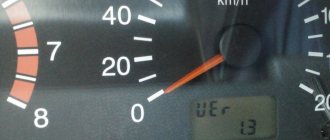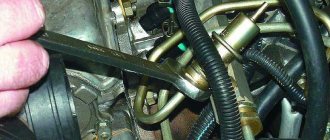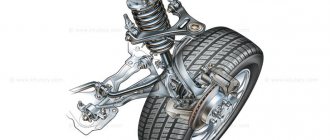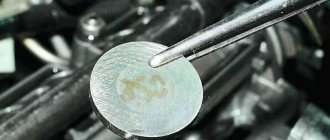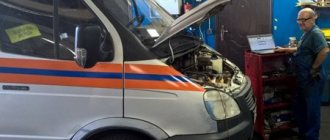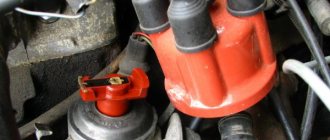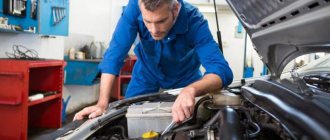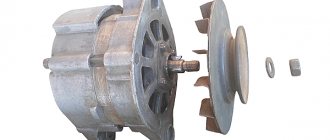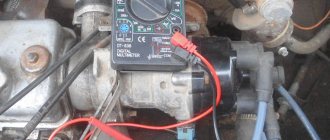Manifestation of the problem
As a rule, if the car jerks, this is usually due to various circumstances. Every driver should understand that any non-standard situations do not appear out of nowhere; this may be due to a malfunction of a particular system. In turn, this is usually due to wear and tear on vehicle components. And if you lose sight of this, sooner or later, it can result in serious and costly repairs.
As for when the problem begins to manifest itself, vehicle jerking can be noticed in the following cases:
- Only when the car starts moving.
- When the engine is running at low speed.
- During a sharp increase in speed.
- When the car is moving at high crankshaft speeds.
- In any mode of vehicle movement, which is manifested by periodic jolts at different times.
But what exactly can cause a vehicle to behave this way? When a VAZ-2114 jerks while driving, there may be several reasons for this, and quite a few. In fact, this is what we will discuss further.
Lost engine thrust: why does this happen and what should the driver do?
As a rule, during the long-term operation of a vehicle, almost every driver sooner or later notices that the engine does not pull well.
In other words, the power unit has difficulty coping with the loads, there is a loss of power, the unit needs to be cranked up to high speeds to maintain the usual pace, the car accelerates worse from a standstill, picks up speed slowly, etc. At the same time, in many cases the engine runs smoothly, does not tremble, there are no increased vibrations, extraneous sounds, knocking or noise during operation of the internal combustion engine. Let us note right away that there is a fairly wide list of possible reasons why a warm engine does not run, and there is a loss of engine power when cold and/or when hot.
In this article we will talk about why the engine does not pull, and also consider the most common malfunctions that manifest themselves in the form of loss of traction of the power unit.
The problem is that when accelerating after 2000 rpm there is a feeling that fuel stops getting into the injectors. The check is not lit, which means there are no errors. The engine is 8 valve. Can anyone tell me where to go?
The pressure in the fuel rail is low, the coolant pump is dying or the fuel filters simply need to be replaced. Well, I had a look at the injectors for spray.
how to do this in a garage? or only in a hundred?
A forum member from Rubtsovka offered you help a long time ago. You've disappeared somewhere.
the mosh valve is burnt out..measure the compression..well, a sophisticated on-board computer is desirable..
By the way, when driving in the rain, the module probably floods... because there are interruptions in 2,, 3 pots... it turns off the forces. stood .. dried .. cleared the errors and flew on. you need to think about how to isolate it from splashes, etc. did anyone have something like this?
in a garage service station. You can try to get confused yourself. You can find everything on YouTube.
sometimes it floods something, I don’t bother. Once he sneezes, the check light comes on for a minute, then goes off and it’s fine. I don’t do anything and won’t. I don’t want to bother with it.
What kind of feeling is this?) and before I actually felt like fuel was pouring like a river into the injectors?)
Describe the problem properly.
Everything should be fine there anyway, in isolation. Look at the wires and connectors. Maybe there is a crack in the MZ body?
To begin with, install the mesh in the tank, you can do it in the yard yourself (wrench 17.7 or 8, pliers, a simple screwdriver and a cross), visually compare it with the new one, and you will understand whether it is very clogged or not. Also change the fine filter (at the bottom of the tank and beam) - a trestle is needed. You can stop by for an express oil change, they will change everything there.
It should help. PS: as they wrote above, I contacted you, if anything happens, I’ll introduce you to normal repairmen (or they’ll just tell you what and how)
To begin with, install the mesh in the tank, you can do it in the yard yourself (wrench 17.7 or 8, pliers, a simple screwdriver and a cross), visually compare it with the new one, and you will understand whether it is very clogged or not. Also change the fine filter (at the bottom of the tank and beam) - a trestle is needed. You can stop by for an express oil change, they will change everything there.
It should help. PS: as they wrote above, I contacted you, if anything happens, I’ll introduce you to normal repairmen (or they’ll just tell you what and how)
What kind of key is this 17.7?)
Do you need a trestle to change the filter? He threw the rag on the ground and crawled under the car.
I’m almost ready to climb under the car on a jack.
At 17, and at 7 or 8 (unscrew the gas tank flap)
Well, yes, let them rack their brains since they don’t want to apply online)))
Yes, with this approach, it’s not at all clear how you got a computer? Previously, they didn’t know it either, and didn’t use it)))
You're doing it right. Providing a reliable support is not a problem. A guy I know got a dozen on his chest. I already wrote in my opinion, although it was a long time ago. Miraculously, he remained alive.
At 17, and at 7 or 8 (unscrew the gas tank flap)
Well, yes, let them rack their brains since they don’t want to apply online)))
It depends on what kind of car it is. The pump cover comes with keys for both 8 and 10 and just plastic on plastic tanks. The tubes come with quick releases or a 17 wrench, but it won’t hurt to hold the mating parts with a 22 wrench. It also won’t hurt to stock up on O-rings right away if the tubes are on nuts.
At 17, and at 7 or 8 (unscrew the gas tank flap)
Well, yes, let them rack their brains since they don’t want to apply online)))
If the engine is 1.6, then you don’t need a key for 17. And the nuts on mine seemed to be 10.
Gee.. Boyanya it turns out already)
Last edited by rmx116; 08/11/2016 at 06:38.
Idle speed sensor
When the driver feels his vehicle begin to jerk, it makes sense to check the condition of the idle speed sensor. At the same time, such a malfunction is very difficult to identify, since often the well-known Check Engine indicator simply does not appear on the dashboard.
For this reason, it is worth checking it first. In this case, the nature of the malfunction may be different. Firstly, the sensor is contaminated with oil, dust, and crankcase gases. Secondly, you should not discount the mechanical nature of the damage - the rod, threaded connections, rivets flying out and other cases. Thirdly, this is a failure of the electrical part.
Transmission
Sometimes the car jerks at low speeds due to the clutch. This may be due to the fact that the springs on the disk, which are needed for a smoother transmission of torque, have failed.
On some cars, for example the 8th generation Honda Civic, jerking when pressing the clutch is a disease and can be treated by lubricating the fork, which moves the release bearing. As for cars with an automatic transmission, kicks and jerks when starting off indicate that the automatic transmission is on the brink, and will most likely need to be repaired soon.
Supply system
As a rule, the main reason that the VAZ-2114 car jerks when driving is due to a malfunction of the power system.
Usually, experienced car enthusiasts and auto mechanics try to look for the cause here first, and they will be right. While the vehicle is starting to move, insufficient fuel may be supplied to the cylinders. This leads to the development of low power, which is not enough for full operation of the transmission.
In other words, if there is an uneven supply of the fuel-air mixture in the power unit, then it will simply not ignite well. In turn, because of this, the timing of the explosion is disrupted, and the heart of the car begins to malfunction. The driver feels this, which causes a lot of discomfort while driving. What can be done:
- Check the functionality of the hall sensor.
- Pay attention to the position of the throttle valve.
- The condition of the injectors also deserves attention.
In addition, to understand the reason why the VAZ-2114 injector twitches when driving, it is necessary to evaluate the condition of each element of the fuel system. Moreover, regardless of the type of power unit. As experts note, due to depressurization of the pipes, the engine experiences fuel starvation. This is manifested by failures in engine operation. Therefore, it is better not to neglect a thorough check of the pipes!
Analysis of the causes of poor engine traction and possible repairs
Fuel filter dirty
This may be due to low-quality gasoline (containing various small debris) or infrequent cleaning of the fuel tank. In this case, you will have to completely replace the entire filter system.
Fuel pump diaphragm clogged
The cause of the blockage, as a rule, is low-quality gasoline. To clean it, just remove the diaphragm and rinse it thoroughly or blow it with air.
Malfunction of the sensor that controls air flow
This is the most common reason why the VAZ 2114 does not work.
- Engine idle speed is too high or low;
- intermittent engine idling;
- disturbed acceleration dynamics. The car becomes uncontrollable and often freezes.
It is worth periodically checking the operating condition of the air flow meter to avoid wasting time and money diagnosing the engine.
Air filter dust
The more the filter is clogged with dust, the less air flows to the engine, therefore, the thrust decreases. What can be done in this case? Ideally, the filter should be replaced with a new one, but if this is not possible, you should remove the filter, tap and blow to remove large debris (flies, dry leaves, insects).
Checking the ignition system
In some cases, the car starts to jerk due to some kind of malfunction in the ignition system. As a rule, the problem can be caused by untimely ignition of the fuel mixture. In rare cases, this is due to a weak spark from the spark plug, which in turn is due to low voltage supplied.
Why does the VAZ-2114 jerk when driving? To do this, during diagnostics it is necessary to check:
- First of all, the performance of the ignition coil.
- Serviceability of spark plugs (it is worth noting that if these elements malfunction, they are replaced as a complete set!).
- Pay attention to the condition of high-voltage wires.
- Are there any problems with the distributor (ignition distributor).
- Condition of the camshaft and crankshaft sensors.
And if the problem is the spark plug, then this is a fairly common and mild case. This type of breakdown is harmless and even a beginner can cope with it. Sometimes the problem may be caused by an incorrect gap between the spark plug contacts, which does not meet established standards.
But if the camshaft position sensor is to blame, then you won’t be able to start the engine at all. In this case, qualified assistance from specialists is necessary.
“Failure” when pressing the gas pedal:
It is better to use it as is, if it is installed standard on your car.
What is the best way to use the return line as it is or to install a tee in front of the fuel pump?
I noticed that such nonsense often happens due to a clogged or muffled return line, the fuel pump pushes the needle of the needle valve and a small but overflow is formed. Basically, this is on an almost worn out valve or from new repair kits produced in the basement, it is unclear where and it is not clear by whom:((. At idle speed it is not there, there is no overflow even when the engine is turned off, excess pressure is created by the fuel pump when the engine speed begins to rise, with a further increase in the level stabilizes due to higher flow.
Everything is told correctly. Reasons and actions.
If implied. that the new carburetor matches the engine and is fully configured and connected correctly, then most likely the problem is in the fuel supply (clogging in the fuel line, faulty fuel pump) or in the ignition system (advance angle, spark plugs, “breaks to ground somewhere”). And also “suction” of air under the carburetor.
And if the new carburetor fails, tell me what to do
For safe movement and normal operation of the power plant, the effective operation of all systems is required. Then the momentum is gained and easily dropped when needed.
Maybe it's all about the checkpoint?
Another version of why the VAZ-2114 twitches while driving affects the transmission mechanism. As a rule, this behavior of the car can be caused by improper operation of the engine and lack of regular maintenance of automatic transmissions. With the total mileage of the car from 100 to 200 thousand km, you should not be surprised at its jerks.
Moreover, even if the box looks good on the outside, it doesn’t mean anything. This is mainly due to excess and lack of transmission oil - it will begin to foam, which leads to twitching.
It is worth paying attention to the following elements:
- Are the fastenings loose or is there damage to the drive cable?
- The shift rod may be damaged.
- The locking device is worn out or deformed.
- The gear fork is worn out.
It is these elements that are responsible for starting the car to move. Therefore, when a VAZ-2114 car jerks, they are also checked first. Fortunately, repair work on the box does not take too long. In a car service center, they will remove and restore the mechanism in almost a couple of hours.
The accelerator also cannot be discounted
At the moment when the driver sharply presses the accelerator pedal, there is a rapid increase in crankshaft revolutions. However, this may cause the vacuum ignition angle regulators to malfunction. Ultimately, the distributor lags at low speeds, and the car begins to jerk.
As the crankshaft speed increases, the engine needs to work faster, igniting and admitting the fuel-air mixture. However, if there are problems with the vacuum regulators, there may be problems with opening the throttle valve and it will not be possible to quickly increase the speed. As a result, gasoline burns at the wrong time, which can damage the bearing responsible for the ignition timing.
To confirm or refute the problem when the VAZ-2114 jerks while driving, it is worth checking the vacuum regulators. Diagnostics is done like this: before starting the engine, you should remove all the pipes with hoses, first covering them with your hands. While the engine is running, you can hear the retractor effect of the regulators.
However, if a vacuum does not form during the working mixture, then the cause of the leakage lies precisely in the damper. The element needs to be replaced.
Air filter?
As is known, the formation of an engine working mixture requires a certain amount of air in which oxygen is present. And without it, the combustion process itself is impossible. In a car, before entering the working chamber, the air passes through the labyrinths of the filter and only after that it combines with the fuel mixture, forming just the working composition.
However, if this element is contaminated, the car may also begin to jerk while driving or when starting off. As a result, the flow decreases significantly and there is simply no longer enough air in the required quantity. This risks the working mixture becoming rich in fuel and burning incorrectly.
As a result of this, the VAZ-2114 jerks when driving, and in some cases there may be misfires.
Another filter - fuel
If everything is in order with the air filter, this does not mean that the fuel cell is “crystal clean”. It is worth checking its condition, because as you know, before the fuel enters the cylinder, where it then burns, releasing energy, it also undergoes cleaning. In most cases, this is also the main problem why the car starts to jerk.
The filter element serves to remove various impurities from the fuel, which do not disappear anywhere, but simply accumulate here. And over time, it begins to clog, and gradually its capacity begins to decrease. As a result, this also leads to “fuel starvation” of the engine. We already know its symptom - the car jerking.
Checking filters
The fuel system of a modern car is equipped with at least three filters. The first of them is, in fact, just a mesh that serves to trap solid particles. It is placed in the neck of the tank, but it is not capable of becoming clogged to such an extent that fuel does not enter the cylinders. In this regard, this filter cannot be the reason that the VAZ-2114 twitches when driving.
The other element is mounted on the fuel pump, which is submerged in the tank. This is the same grid, only with smaller cells. However, the functions are basically the same - to retain large debris. For this reason, it is also clear that it is also not capable of becoming very clogged.
The third element is located after the fuel pump, and it is this filter (it serves for fine cleaning) that can become so clogged that the pump will one day stop coping with its duties.
At the same time, some models may have several additional filters installed. And they may well cause the car to jerk.
The injection engine does not pull
Why does the car not pull if the injection systems are equipped with feedback and can self-regulate in a “closed loop”? Unfortunately, the possibilities for self-regulation are not as wide as we would like.
The first enemy of injection systems is insufficient fuel pressure. When fuel consumption is minimal, the correction margin is sufficient for idling. But as soon as you put a load on the engine, the correction will jump to the maximum threshold, but the injectors will still be “underfilled”.
The pressure in the fuel rail is set by three components: the fuel pump itself, the pressure regulator and a set of filters (coarse and fine). The performance of a working fuel pump is several times greater than the engine needs at maximum flow rate - this is done so that pump wear affects the engine’s operation as little as possible. That’s why a fuel pressure regulator is used, which dumps “excess” fuel either immediately at the pump outlet or from the fuel rail after the fine filter.
In the first case, the fuel rail is called drainless (16-valve VAZ engines, modern foreign cars), in the second - drain. The difference between these systems is the location of the regulator and its operation. On drain ramps, pressure regulators are controlled by the vacuum in the intake manifold; the pressure in the ramp changes depending on the load (at 3 bar, normal for a VAZ, at idle it is 2.3-2.4 bar, take this into account when diagnosing!). On drainless ones, the pressure is maintained constant relative to the atmosphere and is 3.5-4 bar, depending on the car model. An exception is direct injection systems, where the operating pressure ranges from 20 to 70 bar.
Something else useful for you:
The resistance of fuel filters has no effect when measuring fuel pressure “in the plug” (the pump is forcibly turned on with the engine off, when there is no fuel flow in the ramp) and minimally at idle. But under load, an excessive increase in filter resistance reduces the fuel supply to the rail, which will lead to a loss of speed. Therefore, measure the pressure at idle and under load (for example, by hanging the drive axle and braking the wheels in gear). In cases where the idle speed is normal, and problems occur while driving, measuring the pressure only at idle speed (idle) is pointless.
Exception stages during verification:
- Remove the coarse filter (“mesh” at the inlet). This is a known problem for a number of cars - for example, on the second generation Focus.
- Replace the fine filter.
- Measure pressure under load.
- On engines with a drain ramp, clamp or otherwise plug the return line to eliminate the influence of the fuel pressure regulator. On engines with a drainless ramp, the RTD is installed in the fuel pump module; here it is easier to temporarily install a plug washer made of polyethylene or other material under it that is not destroyed by gasoline.
- Measure the pressure again: if it has increased, then the RTD needs to be replaced, otherwise the pump needs to be replaced.
The second reason for “underfilling” is clogged nozzles. Even with normal filter operation, the formation of deposits on the nozzles is inevitable over time. At home, you can only evaluate the shape of the spray pattern by removing the ramp and cranking the engine with the starter (Attention! This procedure is a fire hazard!). A clean nozzle should “dust” evenly, and not produce separate streams or pour to the side. You can evaluate the performance of injectors and compare it with the nominal one only on a bench.
Loss of dynamics is also a consequence of excessively enriched mixture. The fuel pressure regulator cannot be blamed here (the performance of the pump, even when operating without an RTD, is not so high that the correction margin of the injection computer does not cover the enrichment). It is much more likely that the injectors are leaking (again, checked on a bench) or the failure of the sensors that are used to calculate the injection time.
Here the undisputed leader is the mass air flow sensor - an accurate but sensitive device. As the air flow sensor gets dirty and ages, the readings become higher and the car begins to consume significantly more fuel. As a result, the over-enrichment of the mixture can no longer be corrected by the lambda probe. But such a malfunction is immediately visible: the car will begin to smoke, the spark plugs will be covered with black soot. On engines with an absolute pressure sensor, failure of the air temperature sensor is more likely (here it is a separate unit, while in the mass air flow sensor it is built-in).
On cars with an electronic throttle, it is worth checking the operation of the servo drive by removing the pipe from the throttle and allowing it to release gas. The throttle should open evenly, without pauses or wedging, indicating problems with the drive gearbox or critical contamination of the damper (the axle, overgrown with carbon deposits, becomes wedged in the housing).
